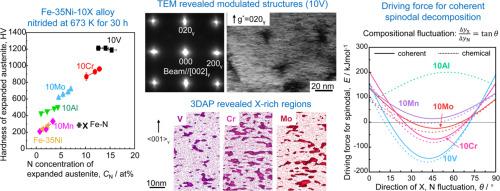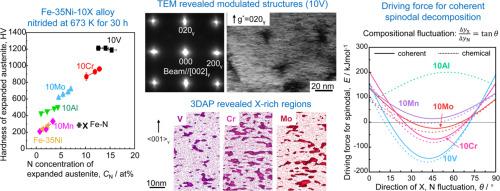Alloying effects on spinodal decomposition induced nano-sized X-N clustering during low-temperature nitriding of austenitic Fe-35Ni-X alloys
IF 9.3
1区 材料科学
Q1 MATERIALS SCIENCE, MULTIDISCIPLINARY
引用次数: 0
Abstract
The addition of Cr is vital for the formation of the expanded austenite (γN) supersaturated by nitrogen (N) during low-temperature nitriding of austenitic steels. Cr-N clustering in γN promoted by Cr-N attractive interaction was recently reported for low-temperature nitrided Fe-35Ni-Cr alloys. However, the effects of other elements having different X-N interactions remain unclear. In the present work, the effect of nitride-forming element X (X = Al, Mo, Mn, Cr, V) addition on the low-temperature nitriding behavior and nanostructure evolution of γN is systematically investigated for austenitic Fe-35Ni-10X (at%) alloys. The addition of X promotes surface N absorption, lattice expansion and thus hardening of γN in the order of Mn<Al<Mo<Cr<V. Transmission electron microscopy (TEM) and three-dimensional atom probe (3DAP) analyses have revealed the formation of nano-scale non-equilibrium X-N clusters in γN as spinodally modulated structures and γ′-Fe4N type long-range ordering (LRO) of N near the surface for the Mo, Cr, and V-added alloys. However, the γN formed in Al or Mn-added alloys shows no X-N clustering or LRO of N. The chemical driving force, strain energy and modulation wavelength for coherent spinodal decomposition were calculated thermodynamically under multi-compositional concentration fluctuations. The driving force for spinodal decomposition increases in the order of X-N attractive interaction, namely Mn<Mo<Cr<V. The calculations agree with the nanostructures observed where the alloy with stronger X-N attractive interaction showed a smaller modulation wavelength.


奥氏体Fe-35Ni-X合金低温渗氮过程中,合金对spinodal分解诱导的纳米X-N聚类的影响
Cr的加入对奥氏体钢低温氮化过程中氮(N)过饱和膨胀奥氏体(γN)的形成至关重要。最近报道了低温氮化Fe-35Ni-Cr合金中Cr-N在γ - n中由Cr-N吸引相互作用促进的聚类现象。然而,具有不同X-N相互作用的其他元素的影响仍不清楚。本文系统研究了氮化形成元素X (X = Al, Mo, Mn, Cr, V)的加入对Fe-35Ni-10X (at%)奥氏体合金低温氮化行为和γN纳米结构演变的影响。X的加入促进了γ - N的表面吸收和晶格膨胀,从而使γ - N按照Mn<;Al<Mo<Cr<;V的顺序硬化。透射电镜(TEM)和三维原子探针(3DAP)分析表明,添加Mo、Cr和v的合金在γ -N中形成了纳米尺度的非平衡X-N簇,形成了独立调制结构,并在表面附近形成了γ′-Fe4N型的N长程有序(LRO)。而添加Al或mn的合金中形成的γN没有X-N聚类,也没有n的LRO。在多组分浓度波动下,热力学计算了相干旋量分解的化学驱动力、应变能和调制波长。独立分解的驱动力按X-N吸引相互作用的顺序增大,即Mn<;Mo<Cr<;V。计算结果与观察到的X-N吸引相互作用较强的合金具有较小的调制波长的纳米结构一致。
本文章由计算机程序翻译,如有差异,请以英文原文为准。
求助全文
约1分钟内获得全文
求助全文
来源期刊

Acta Materialia
工程技术-材料科学:综合
CiteScore
16.10
自引率
8.50%
发文量
801
审稿时长
53 days
期刊介绍:
Acta Materialia serves as a platform for publishing full-length, original papers and commissioned overviews that contribute to a profound understanding of the correlation between the processing, structure, and properties of inorganic materials. The journal seeks papers with high impact potential or those that significantly propel the field forward. The scope includes the atomic and molecular arrangements, chemical and electronic structures, and microstructure of materials, focusing on their mechanical or functional behavior across all length scales, including nanostructures.
 求助内容:
求助内容: 应助结果提醒方式:
应助结果提醒方式:


